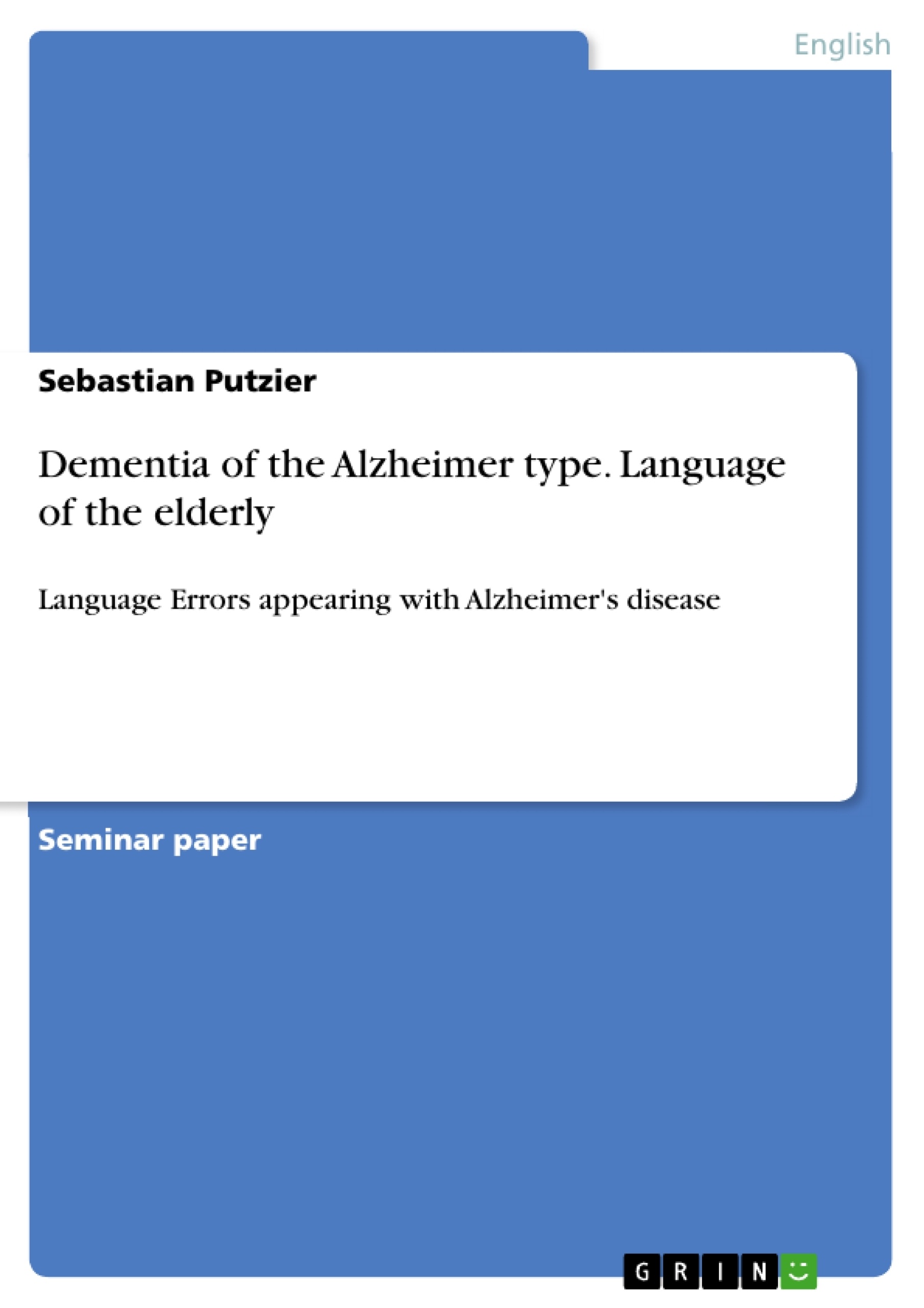What is to be examined in this paper is the overview of the current research status about language pathology in Alzheimer’s disease. The errors of the language system, visible in the lexicon, semantics, lexical semantics, syntax, etc. in reading, writing and spelling of concerned people will be examined. Furthermore, the neuropathological view on the Alzheimer brain will be explained.
In between the last fifteen years, dementia has become one of the main causes of death in industrialized countries. Each year from 1996 to 2006 more than 50-60 percent of the elderly in Germany, Switzerland, Great Britain and the United States of America died of a sort of dementia. Researchers examine disease patterns of dementia and claim coherence between the lifespan of people and the outbreak of dementia diseases. Of course, statistics point out that over the last hundred years the expectancy of life of newborns rose in Germany from 44.8 percent for boys and 48.3 percent for girls in 1901 up to 74.4 percent for boys and 80.5 percent for girls in 1998. Also the lifespan of people aged 60 years and older has risen from 13.1 (males) and 14.2 (females) percent up to 18.9 (males) and 23.2 (females) percent in 1998.
Neuropathologists have been working for more than fifty years to examine and catalogue each variety of the dementia diseases, which becomes more and more difficult as specialized braincast equipments and specific knowledge are updated steadily. Since 1994 the 21st September is declared World Alzheimer's Day™. At this special day of the year, Alzheimer associations prepare information materials and concentrate all their efforts on raising attention about dementia in the eyes of governments, society, medical professionals and people with dementia, their relatives and caregivers.
Inhaltsverzeichnis (Table of Contents)
- Introduction
- 1. The Alzheimer Brain and Language Pathology in the Alzheimer Disease
- 1.1 General acknowledgement about Alzheimer and dementia
- 1.2 Language Pathology in Dementia of the Alzheimer Type (DAT)
- 2. Errors of the Language System
- 2.1 The influence of DAT on the Linguistic Lexicon
- 2.2 Lexical Semantics
- 2.3 Errors of the Linguistic Semantic System
- 2.4 Syntax Errors
- 2.5 Semantic and grammatical processes above single-word level
- 2.6 Reading, Writing and Spelling
- 3. Conclusion
- 4. Future Prospects
Zielsetzung und Themenschwerpunkte (Objectives and Key Themes)
This paper aims to provide an overview of the current research status concerning language pathology in Alzheimer's disease. It focuses on Dementia of the Alzheimer Type (DAT) and examines the errors of the language system, including the lexicon, semantics, lexical semantics, syntax, semantic and grammatical processes, and reading, writing, and spelling.
- The impact of DAT on the linguistic lexicon and semantic memory
- The role of the working memory in language processing and communication
- The influence of DAT on syntax and pragmatic abilities
- The relationship between cognitive decline and the deterioration of reading, writing, and spelling skills
- Future research directions and potential for improving diagnosis and treatment
Zusammenfassung der Kapitel (Chapter Summaries)
The introduction sets the stage by outlining the prevalence of dementia and highlighting the significance of understanding language pathology in Alzheimer's disease. Chapter 1 delves into the characteristics of Alzheimer's brain and the specific language deficits associated with DAT. It explores the distinction between normal aging and dementia, discusses various subtypes of Alzheimer's, and highlights the role of episodic memory in the progression of the disease.
Chapter 2 presents a comprehensive analysis of language errors observed in DAT patients. It examines the influence of DAT on the linguistic lexicon, including the impact on semantic knowledge and the breakdown of lexical semantics. The chapter also explores the effects of DAT on syntax, discussing impairments in sentence structure and the role of working memory in language processing.
Chapter 3 summarizes the key findings of the research, highlighting the vulnerability of the human brain and memory functions, the impact of DAT on stored knowledge and language processing, and the significance of understanding the interconnectedness of cognitive and linguistic abilities.
Schlüsselwörter (Keywords)
This paper explores the language of the elderly, specifically focusing on language errors in dementia of the Alzheimer type. The key themes and concepts include language pathology, Alzheimer's disease, Dementia of the Alzheimer Type (DAT), linguistic lexicon, semantics, syntax, pragmatic abilities, working memory, episodic memory, cognitive decline, and reading, writing, and spelling skills.
- Quote paper
- Sebastian Putzier (Author), 2009, Dementia of the Alzheimer type. Language of the elderly, Munich, GRIN Verlag, https://www.grin.com/document/334408




